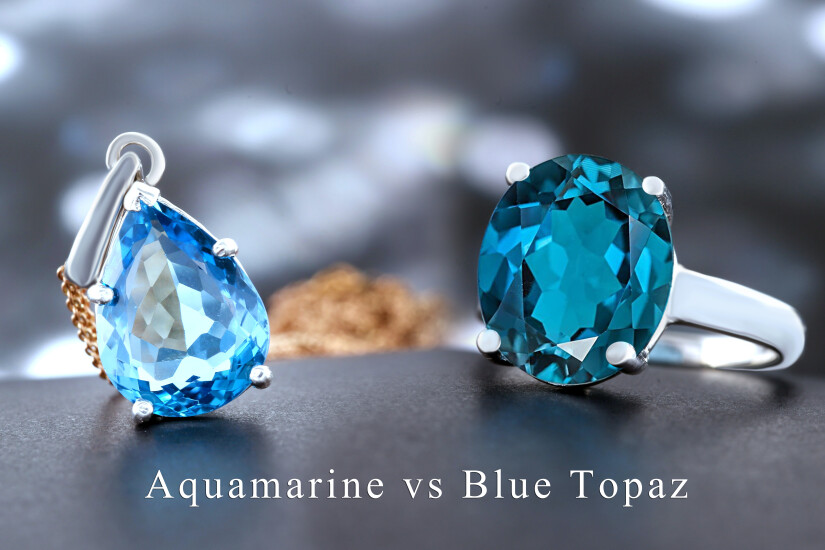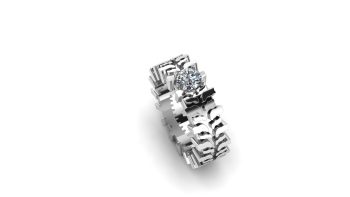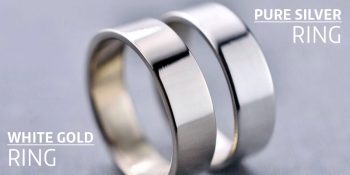Aquamarine vs Blue Topaz. Which one is right for you? They are both blue. They have similar durability. And they can almost be used interchangeably. In fact, many times, topaz is sold as aquamarine to unknowing customers. In this post, we will discuss Aquamarine vs Blue Topaz. Their physical properties, pros & cons, and pricing. After reading this, you should hopefully have a better idea of which one you want. You should at least be better equipped to tell the difference between Aquamarine vs Blue Topaz.
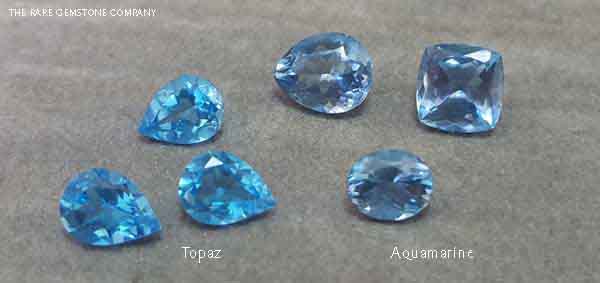
What Is Aquamarine
Aquamarine is a beautiful gemstone that belongs to the beryl family and is closely related to emerald.. It is known for its stunning blue-green color, reminiscent of the clear waters of the ocean. The name “aquamarine” is derived from the Latin words “aqua” meaning water and “marina” meaning sea, perfectly capturing its essence.
This gemstone has been highly valued throughout history for its beauty and symbolism. It is believed to bring calmness, courage, and clarity to the wearer. Aquamarine is also associated with the month of March and is considered the birthstone for those born during this time.
In addition to its aesthetic appeal, aquamarine is also a durable gemstone, making it suitable for everyday wear. It is relatively hard and has good toughness, making it resistant to scratches and breakage. Whether worn as jewelry or used in decorative pieces, aquamarine is sure to add a touch of elegance and tranquility to any setting.
Aquamarine Physical Properties
One of the key physical properties of aquamarine is its hardness. On the Mohs scale, which measures the hardness of minerals, aquamarine ranks at 7.5 to 8. This makes it a durable gemstone that can withstand everyday wear and tear. Its hardness also allows for easy cutting and shaping, making it a popular choice for various jewelry designs.
In addition to its hardness, aquamarine also has excellent clarity. This means that it has few to no visible inclusions or flaws, which enhances its beauty and value. The gemstone is known for its transparency, allowing light to pass through and creating a captivating sparkle. Its clarity, combined with its unique color, makes aquamarine a highly desirable gemstone for both collectors and jewelry enthusiasts.
Another notable physical property of aquamarine is its pleochroism. Pleochroism refers to the ability of a gemstone to exhibit different colors when viewed from different angles. In the case of aquamarine, it typically displays a blue or blue-green color when viewed from one angle, and a lighter, almost colorless hue when viewed from another angle. This optical phenomenon adds to the allure and versatility of aquamarine, making it a fascinating gemstone to admire and wear.
Aquamarine Clarity & Color Range
Aquamarine is a gemstone known for its beautiful blue-green color. It is a variety of the mineral beryl and gets its name from the Latin word “aqua marina,” which means “sea water.” The color of aquamarine can vary from pale blue to deep blue-green, with the most prized specimens being a vivid blue. The clarity of aquamarine is also an important factor in determining its value. Most aquamarines are eye-clean, meaning they have no visible inclusions to the naked eye. However, some may have minor inclusions that can affect their clarity.
Aquamarine is found in many locations around the world, including Brazil, Nigeria, Madagascar, and the United States. The color of aquamarine can vary depending on its origin. For example, aquamarines from Brazil often have a deep blue color, while those from Madagascar tend to have a lighter, more greenish hue. The color of aquamarine is influenced by trace amounts of iron in its crystal structure. The more iron present, the deeper the blue color. In terms of clarity, aquamarine is generally a clean gemstone with few inclusions. However, it is not uncommon to find some inclusions, such as liquid-filled tubes or small crystals, in aquamarines. These inclusions are often seen as part of the stone’s natural beauty and can give it a unique character.
When it comes to choosing an aquamarine, personal preference plays a big role. Some people prefer a lighter, more pastel shade of blue, while others prefer a deeper, more intense blue-green color. The clarity of the stone is also a matter of personal preference. Some people prefer a completely clear stone, while others appreciate the unique inclusions that can be found in aquamarines. Ultimately, the choice of aquamarine comes down to what appeals to you aesthetically.

Pros & Cons Of Aquamarine
One of the main advantages of aquamarine is its beauty. The mesmerizing shade of blue-green can add a touch of elegance to any piece of jewelry. Additionally, aquamarine is a durable gemstone, making it suitable for everyday wear. It is also relatively affordable compared to other gemstones, making it accessible to a wide range of consumers.
However, aquamarine does have some drawbacks. One of the cons is its susceptibility to scratches. Although it is a durable gemstone, it is not as hard as diamonds or sapphires, and therefore requires proper care to avoid damage. Another drawback is that aquamarine can fade over time when exposed to sunlight. It is important to protect the gemstone from prolonged exposure to sunlight to maintain its vibrant color.
What is Blue Topaz
Blue topaz is a gemstone that belongs to the family of silicate minerals. It is known for its beautiful blue color, which can range from a pale sky blue to a deep, vibrant blue. Blue topaz is often used in jewelry, such as rings, necklaces, and earrings, due to its striking color and durability. It is also the birthstone for the month of December, making it a popular choice for those born during that time. Blue topaz is found in various parts of the world, including Brazil, Sri Lanka, and the United States. It is a versatile gemstone that can be cut into different shapes and sizes, allowing for a wide range of jewelry designs. Whether you’re looking for a statement piece or a delicate accessory, blue topaz is a stunning choice that is sure to catch the eye.
Topaz Physical Properties
Topaz is a mineral that is known for its beautiful colors, which range from colorless to yellow, orange, blue, pink, and brown. It is a silicate mineral that belongs to the orthorhombic crystal system. The hardness of topaz is 8 on the Mohs scale, making it a relatively durable gemstone. It has a vitreous luster and a perfect basal cleavage. Topaz is commonly found in granite and pegmatite rocks, as well as in alluvial deposits. It is often used in jewelry, as well as in industrial applications such as abrasives and ceramics.
In addition to its vibrant colors, topaz also exhibits pleochroism, which means that it can appear different colors when viewed from different angles. This property adds to the allure of topaz as a gemstone. Topaz can be found in many locations around the world, including Brazil, Russia, Sri Lanka, and the United States. The largest known topaz crystal, weighing over 600 pounds, was found in Brazil.
When it comes to physical properties, topaz has a specific gravity of 3.4 to 3.6 and a refractive index of 1.61 to 1.64. It has a high birefringence, which means that it can split light into two rays as it passes through the crystal. This property is used in gemological testing to distinguish topaz from other similar gemstones. Topaz is also pleochroic, meaning that it can exhibit different colors when viewed from different angles. Overall, topaz is a fascinating mineral with a wide range of physical properties that make it a popular choice for both jewelry and industrial applications.
Topaz Clarity & Color Range
The color of blue topaz can vary from a pale sky blue to a deep, vibrant blue, offering a wide range of options for those seeking a blue gemstone. They are sold under names like sky blue, london, or swiss topaz. The clarity of blue topaz is usually excellent, with minimal inclusions or blemishes visible to the naked eye, unlike aquamarine. This makes blue topaz a popular choice for jewelry, as it offers both beauty and durability. Whether you prefer a light blue or a dark blue, blue topaz is sure to captivate with its brilliant color and clear, sparkling appearance.

Pros & Cons Of Blue Topaz
There are several pros and cons to consider when it comes to blue topaz. One of the main advantages of blue topaz are the stunning blues it comes in. The blue hue is often associated with calmness and tranquility, making it a popular choice for those seeking a serene and peaceful look. Additionally, blue topaz is relatively affordable compared to other gemstones, making it accessible to a wide range of consumers.
On the other hand, blue topaz does have some drawbacks. One of the main concerns is its durability. Blue topaz is not as hard as other gemstones, such as diamonds or sapphires, which means it can be more prone to scratches and damage. It is important to handle blue topaz with care and avoid exposing it to harsh chemicals or extreme temperatures.
Aquamarine vs Blue Topaz Cost
When it comes to the cost of Aquamarine vs Blue Topaz, there are a few factors to consider. Firstly, Aquamarine tends to be more expensive than Blue Topaz. This is because Aquamarine is a rarer gemstone, found in limited locations such as Brazil, Madagascar, and Nigeria. Its scarcity contributes to its higher price tag. Stones generally fun from around $75 a carat to as much as $1200.
On the other hand, Blue Topaz is more readily available and therefore more affordable. Blue Topaz can be found in various locations around the world, including Brazil, Sri Lanka, and the United States. Its abundance makes it a more budget-friendly option for those looking for a blue gemstone. Topaz generally run from around $5 a carat up to as much $600 for something with natural color.
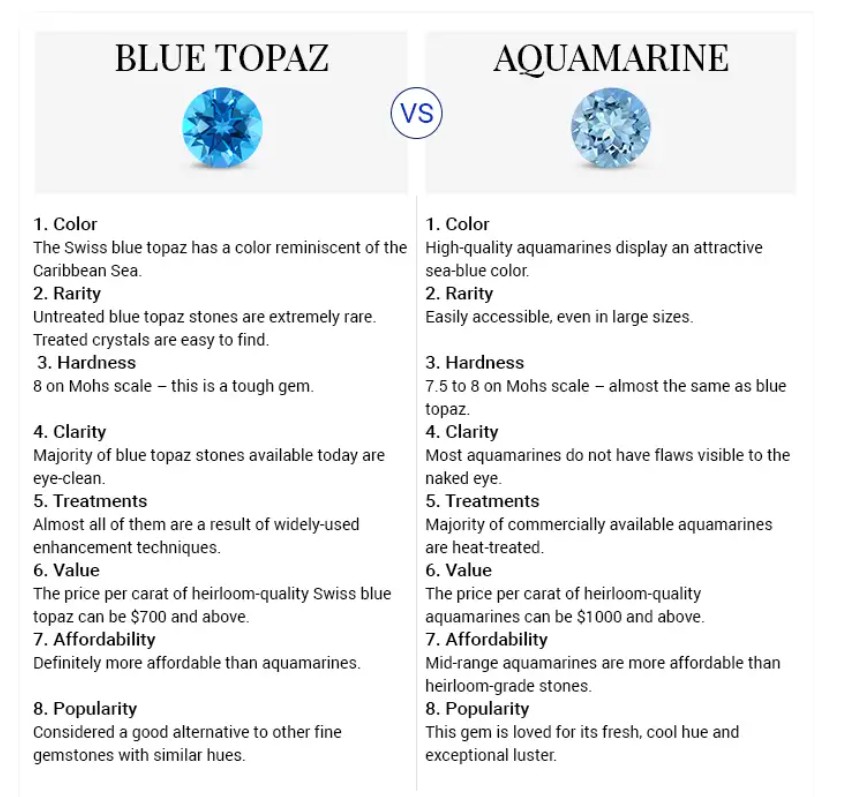
How To Tell The Difference Between Aquamarine vs Blue Topaz
Aquamarine and blue topaz are both beautiful gemstones, but they have distinct characteristics that can help you tell them apart.
Aquamarine is a type of beryl mineral and is known for its pale blue to greenish-blue color. It has a hardness of 7.5 to 8 on the Mohs scale, making it relatively durable. It will most likely have inclusions. There is almost always a green component to aquamarine. Topaz will not have that.
On the other hand, blue topaz is available in a range of blue shades, from light sky blue to deep Swiss blue. Anything too dark will automatically be topaz. It has a hardness of 8 on the Mohs scale, making it slightly harder than aquamarine.

Which Would We Choose?
We would have to go with Aquamarine for several reasons. Firstly, aquamarine is a gemstone with a stunning blue color reminiscent of the clear waters of the ocean. This vibrant hue can add a touch of elegance and sophistication to any piece of jewelry. In contrast, blue topaz can vary in color and may not always achieve the same level of brilliance as aquamarine. The blue can also look artificial.
Second, the most topaz stones are artificially colored. While that is fine, we just prefer the more natural blue that aquamarine has. We also like the aquamarine has a smaller color range. It makes the stone seem more exclusive. And third, we just like the beryl species over topaz. Emeralds and Morganite are also beryl. So the idea that aquamarine is just a trace element away from being a another type of stone is appealing for some reason.
The only time we would choose blue topaz is if it is your birthstone and want a piece of birthstone jewelry.
Regardless, you will be happy with either one you choose. We just hope this has been some help in the Aquamarine vs Blue Topaz question.
You can view our portfolio of custom engagement rings or custom pendants to look for idea. Or you can contact us with your idea for either blue topaz or aquamarine jewelry.
